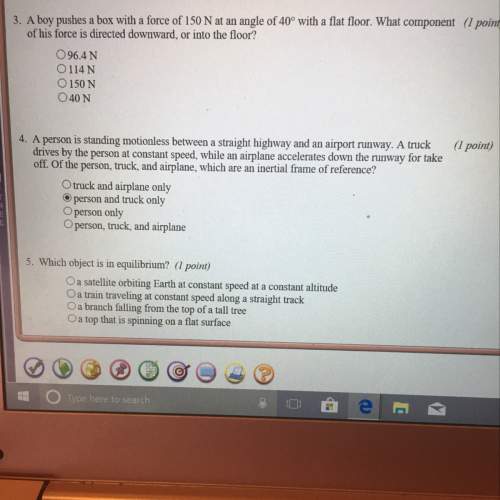
Physics, 20.11.2020 06:20, justicejesusfreak
After rubbing the hair on your head with a balloon, you determine there are 2.4 x 10 18 electrons on your head. What is the charge, in coulombs (C), of your head? Solve and explain how you were able to determine this information.

Answers: 3
Other questions on the subject: Physics

Physics, 22.06.2019 00:30, sophiaa23
Next a skier is pulled by a tow rope up a frictionless ski slope that makes an angle of 15 with the horizontal. the rope moves parallel to the slope with a constant speed of 0.69 m/s. the force of the rope does 800 3 of work on the skier as the skier moves a distance of 8.4 m up the incline. (a) if the rope moved with a constant speed of 2.2 m/s how much work would the force of the rope do on the skier as the skler moved a distance of 8.4 m up the incline? at what rate is the force of the rope doing work on the skier when the rope moves with a speed of (b) 0.69 m/s and (c) 2.2 m/s?
Answers: 1

Physics, 22.06.2019 02:00, Kyliehayden05
Which statements about tornadoes are true? check all that apply. (a) about 12,000 tornadoes hit the united states every year. (b) a tornado looks like a funnel. (c) tornadoes are deadly atmospheric storms that cause millions in damages each year. (d) tornadoes can reach wind speeds of more than 300 miles per hour. (e) kansas is the state with the most tornadoes. (f) you will always notice a funnel before a tornado strikes.
Answers: 2

Physics, 22.06.2019 07:30, anonymous1813
Some material consisting of a collection of microscopic objects is kept at a high temperature. a photon detector capable of detecting photon energies from infrared through ultraviolet observes photons emitted with energies of 0.3 ev, 0.5 ev, 0.8 ev, 2.0ev, 2.5ev, and 2.8ev. these are the only photon energies observed. (a) draw and label a possible energy-level diagram for one of the microscopic objects, which has four bound states. on the diagram, indicate the transitions corresponding to the emitted photons. explain briefly. (b) would a spring–mass model be a good model for these microscopic objects? why or why not? (c) the material is now cooled down to a very low temperature, and the photon detector stops detecting photon emissions. next, a beam of light with a continuous range of energies from infrared through ultraviolet shines on the material, and the photon detector observes the beam of light after it passes through the material. what photon energies in this beam of light are observed to be significantly reduced in intensity (“dark absorption lines”)? explain briefly.
Answers: 3

Physics, 22.06.2019 17:30, BabyG1353
Asilver dollar is dropped from the top of a building that is 1324 feet tall. use the position function below for free-falling objects. s(t) = −16t2 + v0t + s0 (a) determine the position and velocity functions for the coin. s(t) = v(t) = (b) determine the average velocity on the interval [1, 2]. ft/s (c) find the instantaneous velocities when t = 1 second and t = 2 seconds. v(1) = ft/s v(2) = ft/s (d) find the time required for the coin to reach the ground level. (round your answer to three decimal places.) t = s (e) find the velocity of the coin at impact. (round your answer to three decimal places.) ft/s
Answers: 3
Do you know the correct answer?
After rubbing the hair on your head with a balloon, you determine there are 2.4 x 10 18 electrons on...
Questions in other subjects:

Biology, 23.11.2020 16:20

History, 23.11.2020 16:20






Mathematics, 23.11.2020 16:20








